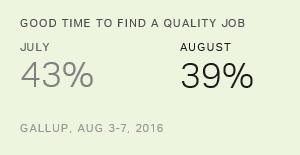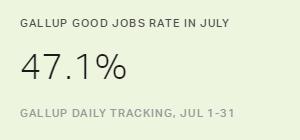Story Highlights
- 20% of U.S. workers say they are making less money than five years ago
- This is down from 28% in 2013
- 23% say job does not take full advantage of their skills, training
PRINCETON, N.J. -- Twenty percent of U.S. workers report they are making less money than they did five years ago, down from 28% when Gallup last asked this question in 2013. Meanwhile, 68% say they are making more money, up from 58% in the prior survey.
| 2013 | 2016 | Change | |||||||||||||||||||||||||||||||||||||||||||||||||||||||||||||||||||||||||||||||||||||||||||||||||
|---|---|---|---|---|---|---|---|---|---|---|---|---|---|---|---|---|---|---|---|---|---|---|---|---|---|---|---|---|---|---|---|---|---|---|---|---|---|---|---|---|---|---|---|---|---|---|---|---|---|---|---|---|---|---|---|---|---|---|---|---|---|---|---|---|---|---|---|---|---|---|---|---|---|---|---|---|---|---|---|---|---|---|---|---|---|---|---|---|---|---|---|---|---|---|---|---|---|---|---|
| % | % | (pct. pts.) | |||||||||||||||||||||||||||||||||||||||||||||||||||||||||||||||||||||||||||||||||||||||||||||||||
| A lot more/A little more | 58 | 68 | +10 | ||||||||||||||||||||||||||||||||||||||||||||||||||||||||||||||||||||||||||||||||||||||||||||||||
| Same amount | 14 | 11 | -3 | ||||||||||||||||||||||||||||||||||||||||||||||||||||||||||||||||||||||||||||||||||||||||||||||||
| A lot less/A little less | 28 | 20 | -8 | ||||||||||||||||||||||||||||||||||||||||||||||||||||||||||||||||||||||||||||||||||||||||||||||||
| Based on those employed full or part time | |||||||||||||||||||||||||||||||||||||||||||||||||||||||||||||||||||||||||||||||||||||||||||||||||||
| Gallup, Aug. 3-7, 2016 | |||||||||||||||||||||||||||||||||||||||||||||||||||||||||||||||||||||||||||||||||||||||||||||||||||
These results are based on Gallup's annual Work and Education survey. They indicate that most U.S. workers are seeing gains in pay -- including 31% who say they are making "a lot more." A substantial minority report making less money, including 13% who say they are making "a lot less." In 2013, a slightly higher 18% said they were making a lot less money.
These data shed some additional light on recent U.S. employment trends. While measures of unemployment have recovered to where they were before the Great Recession, other statistics indicate that gains in low-wage, low-skill jobs have greatly outpaced gains in middle-income jobs. Thus, economists and political leaders have debated how strong the jobs recovery has been and how healthy the employment market is for U.S. workers. A recent analysis by the Federal Reserve Bank of New York, however, indicates middle-income job growth has picked up.
Given the increase since 2013 to 68% of U.S. workers saying they are making more money than five years ago, the majority of workers appear to be benefiting as employment rates have improved.
The poll did not probe for reasons why one in five workers are making less money. But several possibilities exist -- perhaps workers who lost their job in recent years could not find a new one that paid as well, while self-employed workers' businesses may not be doing as well as in the past. Some employees may have opted to work part time rather than full time for family or other reasons.
Notably, there is little difference in the percentages of workers saying they are making less money than five years ago based on tenure with their company. While 22% of those employed at their job for less than five years say they are making less money, nearly as many who have worked in their job for five to 10 years (19%) or for more than 10 years (19%) also report making less money. In other words, workers who were already in their job before the recession began are just as likely as those who began working after the recession to say they are making less money. This indicates that the narrative of wages declining because people lost higher-paying jobs during the recession and were forced to take lower-paying jobs may be overstated.
Employees who work less than 40 hours per week (34%) are more than twice as likely as those who work 40 hours or more (16%) to say they are making less money than they did five years ago. Similarly, hourly workers (23%) are more likely than salaried workers (13%) to report they are making less money.
| Making more | Making same | Making less | ||||||||||||||||||||||||||||||||||||||||||||||||||||||||||||||||||||||||||||||||||||||||||||||||||
|---|---|---|---|---|---|---|---|---|---|---|---|---|---|---|---|---|---|---|---|---|---|---|---|---|---|---|---|---|---|---|---|---|---|---|---|---|---|---|---|---|---|---|---|---|---|---|---|---|---|---|---|---|---|---|---|---|---|---|---|---|---|---|---|---|---|---|---|---|---|---|---|---|---|---|---|---|---|---|---|---|---|---|---|---|---|---|---|---|---|---|---|---|---|---|---|---|---|---|---|---|
| % | % | % | ||||||||||||||||||||||||||||||||||||||||||||||||||||||||||||||||||||||||||||||||||||||||||||||||||
| Job tenure | ||||||||||||||||||||||||||||||||||||||||||||||||||||||||||||||||||||||||||||||||||||||||||||||||||||
| Less than five years | 67 | 10 | 22 | |||||||||||||||||||||||||||||||||||||||||||||||||||||||||||||||||||||||||||||||||||||||||||||||||
| Five to 10 years | 70 | 11 | 19 | |||||||||||||||||||||||||||||||||||||||||||||||||||||||||||||||||||||||||||||||||||||||||||||||||
| More than 10 years | 66 | 14 | 19 | |||||||||||||||||||||||||||||||||||||||||||||||||||||||||||||||||||||||||||||||||||||||||||||||||
| Hours worked | ||||||||||||||||||||||||||||||||||||||||||||||||||||||||||||||||||||||||||||||||||||||||||||||||||||
| Less than 40 hours | 46 | 20 | 34 | |||||||||||||||||||||||||||||||||||||||||||||||||||||||||||||||||||||||||||||||||||||||||||||||||
| 40 hours or more | 74 | 9 | 16 | |||||||||||||||||||||||||||||||||||||||||||||||||||||||||||||||||||||||||||||||||||||||||||||||||
| Pay status | ||||||||||||||||||||||||||||||||||||||||||||||||||||||||||||||||||||||||||||||||||||||||||||||||||||
| Hourly | 66 | 10 | 23 | |||||||||||||||||||||||||||||||||||||||||||||||||||||||||||||||||||||||||||||||||||||||||||||||||
| Salary | 73 | 13 | 13 | |||||||||||||||||||||||||||||||||||||||||||||||||||||||||||||||||||||||||||||||||||||||||||||||||
| Based on those employed full or part time | ||||||||||||||||||||||||||||||||||||||||||||||||||||||||||||||||||||||||||||||||||||||||||||||||||||
| Gallup, Aug. 3-7, 2016 | ||||||||||||||||||||||||||||||||||||||||||||||||||||||||||||||||||||||||||||||||||||||||||||||||||||
Gallup did not ask workers in the 2013 survey how long they have worked for their company and how they are paid, so it is not possible to know if the proportions of workers making less money in these subgroups have changed.
Gallup did, however, assess number of hours worked in 2013. The percentage of those working 40 hours or more per week who say they are making more has increased from 63% to 74%, while the percentage saying they are making less has fallen from 23% to 16%. There has been a similar decrease in the percentage of employees working less than 40 hours reporting they are making less money, from 42% in 2013 to 34% today. But there has been very little increase in the percentage of these workers saying they are making more, from 43% to 46%. Rather, the percentage of this group saying they are making the same amount of money has risen from 13% to 20%.
About One in Four Workers Say They Are Overqualified for Position
In addition to the question about pay, the poll for the first time measured how many workers might be settling for jobs for which they are overqualified. Twenty-three percent say their job does not take full advantage of their skills and training. However, 70% say their job is a good match. The remaining 6% indicate they are underqualified for their job, saying it is a little beyond their skills and training.
| % | |||||||||||||||||||||||||||||||||||||||||||||||||||||||||||||||||||||||||||||||||||||||||||||||||||
|---|---|---|---|---|---|---|---|---|---|---|---|---|---|---|---|---|---|---|---|---|---|---|---|---|---|---|---|---|---|---|---|---|---|---|---|---|---|---|---|---|---|---|---|---|---|---|---|---|---|---|---|---|---|---|---|---|---|---|---|---|---|---|---|---|---|---|---|---|---|---|---|---|---|---|---|---|---|---|---|---|---|---|---|---|---|---|---|---|---|---|---|---|---|---|---|---|---|---|---|
| Job is good match for skills/training | 70 | ||||||||||||||||||||||||||||||||||||||||||||||||||||||||||||||||||||||||||||||||||||||||||||||||||
| Job doesn't take advantage of skills/training | 23 | ||||||||||||||||||||||||||||||||||||||||||||||||||||||||||||||||||||||||||||||||||||||||||||||||||
| Job is beyond skills/training | 6 | ||||||||||||||||||||||||||||||||||||||||||||||||||||||||||||||||||||||||||||||||||||||||||||||||||
| Based on those employed full or part time | |||||||||||||||||||||||||||||||||||||||||||||||||||||||||||||||||||||||||||||||||||||||||||||||||||
| Gallup, Aug. 3-7, 2016 | |||||||||||||||||||||||||||||||||||||||||||||||||||||||||||||||||||||||||||||||||||||||||||||||||||
Hourly workers (34%) are more than twice as likely as salaried workers (15%) to say their skills are not fully utilized in their job. Eighty-two percent of salaried workers, compared with 56% of hourly workers, say their job is a good match for their skills and training.
Also, employees who have less tenure with their company are less likely to believe their job is a good match for their skills and training. Thirty percent who have been with their employer for less than five years believe their skills are underutilized in their role, compared with 22% of those who have worked for their employer for five to 10 years and 15% of those who have been with the same employer for more than 10 years. This does not appear to be a function of younger workers disproportionately having less tenure, as the percentage of workers who believe they are overqualified is similar by age.
| Good match | Does not utilize skills | Is beyond skills | ||||||||||||||||||||||||||||||||||||||||||||||||||||||||||||||||||||||||||||||||||||||||||||||||||
|---|---|---|---|---|---|---|---|---|---|---|---|---|---|---|---|---|---|---|---|---|---|---|---|---|---|---|---|---|---|---|---|---|---|---|---|---|---|---|---|---|---|---|---|---|---|---|---|---|---|---|---|---|---|---|---|---|---|---|---|---|---|---|---|---|---|---|---|---|---|---|---|---|---|---|---|---|---|---|---|---|---|---|---|---|---|---|---|---|---|---|---|---|---|---|---|---|---|---|---|---|
| % | % | % | ||||||||||||||||||||||||||||||||||||||||||||||||||||||||||||||||||||||||||||||||||||||||||||||||||
| Job tenure | ||||||||||||||||||||||||||||||||||||||||||||||||||||||||||||||||||||||||||||||||||||||||||||||||||||
| Less than five years | 59 | 30 | 11 | |||||||||||||||||||||||||||||||||||||||||||||||||||||||||||||||||||||||||||||||||||||||||||||||||
| Five to 10 years | 75 | 22 | 3 | |||||||||||||||||||||||||||||||||||||||||||||||||||||||||||||||||||||||||||||||||||||||||||||||||
| More than 10 years | 82 | 15 | 3 | |||||||||||||||||||||||||||||||||||||||||||||||||||||||||||||||||||||||||||||||||||||||||||||||||
| Hours worked | ||||||||||||||||||||||||||||||||||||||||||||||||||||||||||||||||||||||||||||||||||||||||||||||||||||
| Less than 40 hours | 59 | 28 | 13 | |||||||||||||||||||||||||||||||||||||||||||||||||||||||||||||||||||||||||||||||||||||||||||||||||
| 40 hours or more | 74 | 22 | 4 | |||||||||||||||||||||||||||||||||||||||||||||||||||||||||||||||||||||||||||||||||||||||||||||||||
| Pay status | ||||||||||||||||||||||||||||||||||||||||||||||||||||||||||||||||||||||||||||||||||||||||||||||||||||
| Hourly | 56 | 34 | 10 | |||||||||||||||||||||||||||||||||||||||||||||||||||||||||||||||||||||||||||||||||||||||||||||||||
| Salary | 82 | 15 | 3 | |||||||||||||||||||||||||||||||||||||||||||||||||||||||||||||||||||||||||||||||||||||||||||||||||
| Based on those employed full or part time | ||||||||||||||||||||||||||||||||||||||||||||||||||||||||||||||||||||||||||||||||||||||||||||||||||||
| Gallup, Aug. 3-7, 2016 | ||||||||||||||||||||||||||||||||||||||||||||||||||||||||||||||||||||||||||||||||||||||||||||||||||||
Implications
Workers' reports on whether their pay has increased or decreased in recent years present mixed news about the job market. It is encouraging that the typical worker is making more money than five years ago. That said, that one in five workers is making less at a time when unemployment is low is concerning. Gallup has asked this question only once previously, so it is difficult to establish what a "normal" percentage of those who say they are making less might be. But today's 20% is down from 28% in 2013, and indicates the pay situation for U.S. workers is at least improving.
Workers who have more tenure at their company, including those who first started their job before the recession began, are nearly as likely as those with less tenure to indicate they are making less than they did five years ago. This, along with larger differences between salaried and hourly workers, suggests that a worker's specific role, or perhaps the company's performance, may have nearly as much effect on worker pay as changes in the job market brought about by the Great Recession.
It is less clear how much of a role the recession has played on the match between employees' jobs and their skills. There is a stronger tendency for employees with less than five years' tenure to say they are overqualified for their job. But what the data do not tell us is whether that's because these workers were forced to take a lesser job post-recession, or because they are workers who have not yet proven themselves to their employers but may -- as is the case for more tenured employees -- do so in time.
Historical data are available in Gallup Analytics.
Survey Methods
Results for this Gallup poll are based on telephone interviews conducted Aug. 3-7, 2016, with a random sample of 521 adults, aged 18 and older, living in all 50 U.S. states and the District of Columbia who are employed full or part time. For results based on the total sample of workers, the margin of sampling error is ±6 percentage points at the 95% confidence level. All reported margins of sampling error include computed design effects for weighting.
Each sample of national adults includes a minimum quota of 60% cellphone respondents and 40% landline respondents, with additional minimum quotas by time zone within region. Landline and cellular telephone numbers are selected using random-digit-dial methods.
View complete question responses and trends.
Learn more about how the Gallup Poll Social Series works.




